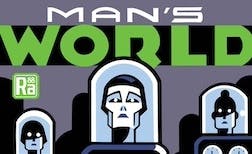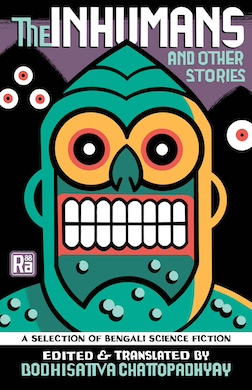Tracing Science Fiction to Its Outer Edges
Edited by Joshua Glenn, a semiotician and scholar with little patience for academia, a series of books from the MIT Press is an attempt to, if not set the literary record straight, then give it a wider grounding.

‘The Inhumans and Other Stories’
Edited by Bodhisattva Chattopadhyay
MIT Press
‘Man’s World’
By Charlotte Haldane
MIT Press
“Although the beginning of my tale will undoubtedly shock you, I think you will find that, by its conclusion, horror has given way to riotous hilarity.” So begins the story within a story that is “The Inhumans,” a 1935 science fiction novella by Hemendrakumar Roy (1888-1963).
Those familiar with Roy’s literary output — a slim audience, I would think, outside of Bengali circles — know him as a popularizer of children’s fiction and detective stories in his native India. Given Roy’s additional duties as a translator of English and French texts, it seems a wonder that he found time to write about, among much else, a feral woman raised by gorillas.
Our ape-lady — the locals know her as “Tana” — plays a minor role in “The Inhumans,” Roy’s tale of intrepid explorers in the far reaches of Africa. Other players include a raft of angry hippos, a mad scientist who resembles a barrel, and a raft of indigenous people our narrator dubs valakhilyas, a reference to mythical thumb-sized people found in Hindu literature. We are also cautioned that otherworldly phenomena shouldn’t necessarily be dismissed as “the ramblings of a cannabis smoker.”
“The Inhumans and Other Stories; A Selection of Bengali Science Fiction” is among the latest in a series of books published by the MIT Press under the umbrella of “the Radium Age.” Its editor is Joshua Glenn, a semiotician and scholar with little patience for academia. For about a decade, he was the braintrust behind Hermenaut, a print journal of “heady philosophy” that was “a sounding board for thinking folk who operate outside the ivory tower.”

Mr. Glenn has worked for mainstream outlets — the Boston Globe, for one — but his heart seems more firmly ensconced on the outskirts of polite culture. The MIT books are an attempt to, if not set the literary record straight, then give it a wider grounding. If the golden age of science fiction can roughly be parceled between the mid-1930s and early 1960s, what are we to make of speculative writing that predates that timeframe?
Using Marie Curie as a standard-bearer, Mr. Glenn posits “The Radium Age” as the post-Victorian/pre-atomic age era of science fiction. Taking a leaf from author and critic Brian Stableford, he locates a continuity in “the difficult diplomacy of existence in a scientifically knowable but essentially unimaginable world.” The cover designs for the series are the work of Gregory Gallant, better known as “Seth.” His illustrations achieve an eye-grabbing balance between the futuristic and the retro.
The first volume in the series, “Voices From the Radium Age,” includes stories by authors whose fame lies outside the genre, including E.M. Forster, Jack London, and W.E.B. DuBois. The 15 books that have since appeared continue to offer names recognizable to the layman (H.G. Wells, Arthur Conan Doyle, G.K. Chesterton) along with authors who might test the reach of even the most stalwart sci-fi fan (Cicely Hamilton, E.V. Odie, and Pauline Hopkins). The two latest volumes are par for a series that, on the whole, travels off the course.
“The Inhumans and Other Stories” has been edited and translated by Bodhisattva Chattopadhyay, a professor at the University of Oslo and an advocate for Bangla science-fiction. Mr. Chattopadhyay is to quick to note how snugly Roy’s story fits within the Lost Race trope — that is to say, the discovery of creatures who are either (a) light years ahead of humankind in terms of scientific achievement; or (b) light years behind us in the same.
“The Inhumans” operates on both fronts, opting to treat the former as comedy and the latter as adventure. Mr. Chattopadhyay divines anti-colonialist sentiment within Roy’s satirical take on the strictures of civilization, but doesn’t speak to the ramshackle structure of the story — the sense that it was made up on the fly and had little doubling-back for narrative nipping-and-tucking. The three short stories that fill out the volume, especially Jagadananda Ray’s “Voyage to Venus” (1895), are all the better for firming up the fantastical through concision of means.
“Man’s World” (1926), by a pioneering British feminist, Charlotte Haldane, is a dystopian conundrum and an alarming read. This stern philosophical tract posing as a futuristic fantasy predates Aldous Huxley’s “Brave New World,” but both books share a chilly cynicism indicative of intellectual currents of the day. “The so-called value of human life is always a debatable factor,” protagonist Christopher states, “its sanctity is a matter of sentiment, not reason.”
Welcome to a future in which a patriarchal governing body segregates women into two classes: “neuters” and “mothers.” This system was, ironically enough, determined by a woman: It was through the initiative of Lady Ann Thomas that scientific experiments employed on cattle were subsequently used on human subjects. The results, having been deemed successful, were subsequently instituted throughout the entirety of human society, one in which “women outgrew the family just as government outgrew empire and thought outgrew religions.”
Not all goes well in Hadane’s novel, not least because it’s a hotbed of contradictory impulses. Did she borrow H.G. Wells’s time machine in order to travel to the 21st century? There isn’t a modish theory or ugly conspiracy that “Man’s World” doesn’t mix-and-match: genetic engineering, white supremacy, queer culture, the failures of Western civilization, the benefits of mysticism, environmental alarmism, and, that old standby, antisemitism. This is a book over which Marjorie Taylor Greene and Judith Butler could break bread, and then invite the ghosts of Michel Foucault, Margaret Sanger, and Hugh Hefner for an after-dinner digestif. It’s that weird.
A professor at the University of Texas at Austin, Philippa Levine, notes in the introduction that Haldane’s novel “takes us on a variety of journeys … letting readers choose which of her sometimes conflicting but always robust modernist messages matter the most.” Sometimes conflicting? That’s soft-pedaling a confused, somewhat stodgy, and, in the end, kinky parable that is one woman’s take on a man’s world.

